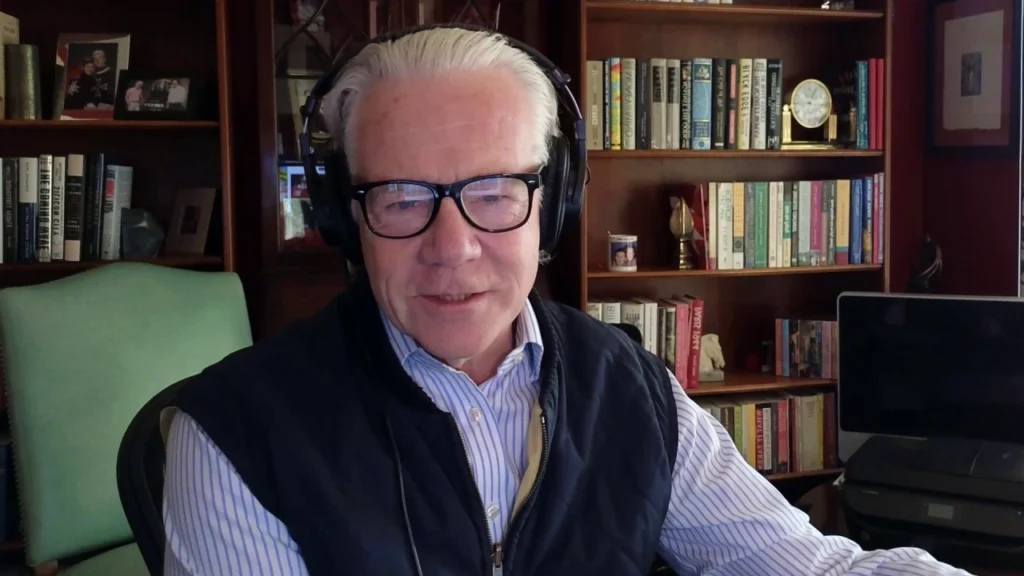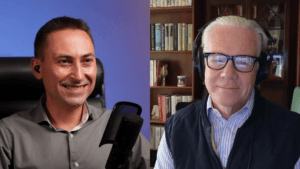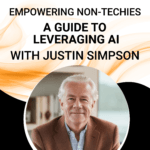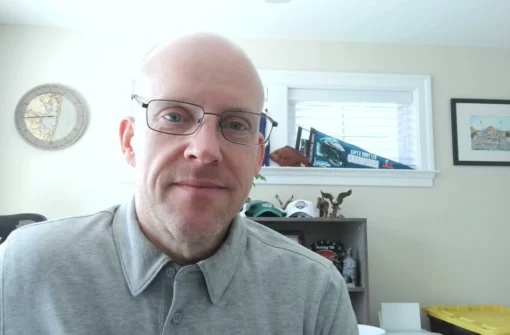
Empowering Non-Techies: A Guide to Leveraging AI with Justin Simpson
AI news moves faster than you can keep up—so why even try? If you’ve ever felt overwhelmed by the nonstop flood of AI breakthroughs, you’re not alone. In this episode of Innovation Tales, Alexandre Nevski chats with Justin Simpson, co-founder of Here.Now.AI, about the growing AI divide—why some are thriving while others feel left behind. Justin breaks down practical, no-nonsense ways to cut through the noise, experiment with AI, and start using it to work smarter, not harder. No hype, no jargon—just real-world strategies to help you and your team stay ahead.
Key Takeaways
- The AI divide is real: Some professionals are thriving with AI, while others struggle to keep up. Understanding and leveraging AI is crucial to staying competitive.
- Hands-on experimentation is key: Waiting for AI to become simpler isn’t an option. Engaging with AI tools now will help individuals and businesses adapt more effectively.
- AI is not just for tech experts: From small businesses to corporate teams, anyone can use AI to boost productivity, automate tasks, and unlock new opportunities.
The Growing AI Divide
AI is reshaping industries at an unprecedented pace, but not everyone is keeping up. Some professionals and businesses are embracing automation, machine learning, and human-AI collaboration, while others feel left behind. This “AI divide” is creating gaps in productivity, efficiency, and even job security.
Justin Simpson believes that AI is too powerful to be reserved for the tech elite. He emphasizes that AI is a tool that should be accessible to everyone, from small business owners to corporate leaders. The key, he argues, is experimentation—diving in and finding practical ways AI can enhance everyday tasks.
“Have you noticed the growing divide between those who are thriving with artificial intelligence and those who are being left behind?”
Meet Justin Simpson: Making AI Accessible
As the co-founder of Here.Now.AI, Justin has built a platform dedicated to making AI understandable and useful for non-technical users. His newsletter, reaching over 20,000 subscribers, distills complex AI trends into practical insights and tools that anyone can use.

Justin’s mission is simple: AI should help people work smarter, not harder. He sees AI as a productivity booster, an assistant that can streamline tasks, improve efficiency, and unlock new creative possibilities. But, as he points out, getting started requires a mindset shift—moving from skepticism to hands-on engagement.
“Enter Justin Simpson, co-founder of Here.Now.AI, whose weekly newsletter helps over 20,000 readers make sense of AI without drowning in jargon.”
Understanding the AI Divide
The AI divide isn’t just about knowledge—it’s about access, mindset, and willingness to adapt. While large enterprises are already using AI to automate workflows and enhance decision-making, many smaller businesses and individuals hesitate to explore AI-driven tools. This hesitation often stems from misconceptions: that AI is too complicated, too expensive, or only useful for highly technical fields.
However, Justin emphasizes that waiting for AI to become “simple” or “perfect” can be a costly mistake. AI is already influencing the workplace, with companies expecting employees to increase productivity by leveraging these tools. In some cases, AI isn’t taking jobs—it’s giving an advantage to those who know how to use it.
“Your job won’t be taken by AI, but your job could be taken by someone who knows how to leverage AI.”
Justin’s Newsletter: Practical AI for Everyone
To bridge the AI divide, Justin launched his weekly newsletter, which highlights AI applications that anyone can use—whether for work, creativity, or personal productivity. Each week, he evaluates dozens of AI tools, selecting only those that are practical, easy to use, and relevant for non-tech professionals.
His approach is hands-on: rather than debating AI ethics or long-term impact, he encourages people to experiment. Some tools are purely functional, such as AI-powered writing assistants, while others offer more creative uses, like generating music or enhancing images.
“For general people, the best way to experience what AI is, is to do something with it.”
Exploring AI Tools and Applications
One of the most exciting aspects of AI is its versatility. Justin shares examples of how different people have integrated AI into their workflows:
- A tattoo artist using AI tools to convert static images into engaging video content for social media.
- Professionals leveraging AI-powered transcription software to improve productivity and eliminate manual note-taking.
- Small business owners automating customer service responses, enhancing their marketing strategies, and streamlining operations.
He encourages users to start with mainstream AI chatbots like ChatGPT and Gemini, which have evolved far beyond simple Q&A tools. These platforms can now execute tasks, store personalized information, and function as collaborative partners rather than just knowledge sources.
“I put out a story about an app, which takes a photograph of a family member or yourself and turns it into a Pixar cartoon.”
AI Workshops: Bridging the Gap in Businesses
Beyond individual experimentation, Justin also helps organizations navigate AI adoption through hands-on workshops. He has observed a significant gap between companies’ AI policies and employees’ desire to leverage AI tools. Many companies still lack a clear AI strategy, leaving employees to figure it out on their own.
Justin’s workshops address key challenges:
- Identifying AI opportunities in different business functions.
- Understanding risks and ethical considerations.
- Balancing AI experimentation with corporate governance.
- Developing effective prompting techniques for AI chatbots.
Unlike traditional top-down technology rollouts, AI adoption works best from the ground up. Employees experimenting with AI-driven solutions in their daily work can drive meaningful innovation. The key is to provide structured guidance while allowing flexibility.
“Three hours of engaged workshop is really a sort of covers the sectors and then a full day gives you really, more opportunity to dive into some of the topics.”
Real-World AI Success Stories
Justin shares compelling success stories from businesses that have embraced AI:
- A security firm: A two-person business leveraged AI to produce high-quality industry newsletters, making them appear as a much larger organization.
- A former radio personality turned coach: Used AI to prepare for client engagements, generating social media strategies and media training exercises.
These examples highlight how AI isn’t just for large corporations—it’s a game-changer for small and medium-sized businesses as well.
“With a little bit of work from AI, he is putting out a newsletter, which makes it look as if it’s a 30-man corporate operation.”
What’s Next? AI as a Daily Habit
For those looking to get started with AI, Justin recommends building a habit of regular experimentation:
- Dedicate 30 minutes each week to exploring AI tools.
- Identify repetitive tasks that could be automated.
- Experiment with AI assistants for summarizing documents, generating reports, or drafting communications.
- Use AI for creative applications, such as language learning or content creation.
He also highlights emerging AI capabilities, such as automated research assistants and AI-driven task execution. In the near future, AI won’t just provide information—it will handle complex tasks, like planning vacations, managing schedules, and automating entire workflows.
“The best way to understand the power of AI is to experiment with it—set aside time to play, push the boundaries, and find that ‘aha’ moment.”
Final Thoughts on the Future of AI
Despite rapid advancements, one thing will remain constant: human creativity. AI can generate content, analyze data, and optimize workflows, but true innovation still relies on human insight, intuition, and critical thinking. The key to thriving in an AI-powered world isn’t resisting change—it’s actively participating in it.
“At the end of it, the stuff that’s really going to matter is the stuff that isn’t programmable, that just resides in the human brain and the human instinct and the human creative spirit.”
Conclusion
The AI revolution is here, and the gap between those who embrace it and those who hesitate is growing. As Justin Simpson highlights, AI is not just for tech experts—it’s a tool that can enhance productivity, streamline tasks, and open new opportunities for individuals and businesses alike. The key is hands-on experimentation and a willingness to adapt. Whether through AI-driven newsletters, workshops, or simple daily experiments, taking small steps today can make a big difference in staying competitive and future-proofing your career.

Explore Practical AI with Here.Now.AI
Want to stay ahead in the evolving world of AI? Subscribe to Here.Now.AI, Justin Simpson’s weekly newsletter, for practical insights and real-world applications. Looking for a more hands-on approach? Join a corporate or group workshop to break down barriers to AI adoption, build essential skills, and develop a strategic AI roadmap tailored to your organization’s needs.
Join the Conversation
How do you see AI fitting into your daily work or business? Are there challenges you face in adoption, or have you had an “aha” moment using AI? Share your thoughts with the Innovation Tales community on LinkedIn—we’d love to hear your experiences!
Further Reading
- The Coming Wave by Mustafa Suleyman – A must-read on how AI is reshaping our world.

Episode timeline:
- 00:00 Introduction: The Growing AI Divide
- 00:00 Meet Justin Simpson: Making AI Accessible
- 00:00 Understanding the AI Divide
- 00:00 Justin's Newsletter: Practical AI for Everyone
- 00:00 Exploring AI Tools and Applications
- 00:00 AI Workshops: Bridging the Gap in Businesses
- 00:00 Conclusion: Embracing AI for a Better Future





